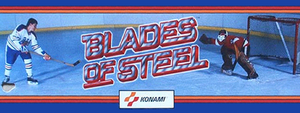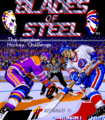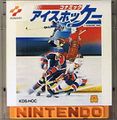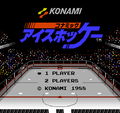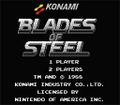After Konami hit upon a successful formula for basketball with Double Dribble, they went on to create a hockey game in a similar vein. The result was Blades of Steel, later released in Japan as Konamic Ice Hockey (コナミック アイスホッケー?), an ice hockey game released by Konami for North American arcades in 1987, and ported to the Famicom Disk System and NES in 1988. All teams are fictional but based out of real Canadian and American cities. In comparison to Nintendo's own entry of the sport, Ice Hockey, Blades of Steel focuses more on a less-cartoony look and more realistic presentation. The game is known for its fast paced hockey action and for the inclusion of fights that break out between opposing players.
Blades of Steel differs from the professional game in the NHL in the late 1980s in that it has no offside rule, and its interpretation of penalties is somewhat unique. The game's officials only call two penalties. Players who lose a fistfight are penalized for two minutes, an abstract reworking of the five-minute offsetting majors normally assigned in the event of a fight. Should a fight break out in front of one team's net, then the player on offense gets a penalty shot. The penalty shot is administered in the style of a soccer penalty shot, in that the shooting player must stand on the blue line, instead of moving towards the goaltender. The game also recognizes icing infractions, with an appropriate game reset and faceoff in the liable team's zone.
Blades of Steel has been well received by critics, regarded not only as a good hockey game for the NES, but also as one of the best hockey games ever created. The NES conversion remains faithful to the original arcade version, while also introducing some new concepts, including a mini-game based upon the boss battle in Gradius. The NES version was re-released on Nintendo's Virtual Console service on December 24, 2007. The arcade version was re-released on Microsoft's Game Room service on November 24, 2010.
-
Arcade title screen.
Arcade
Controls
- Trackball: The arcade version of the game utilizes a trackball in order to direct players around the ice rink. The trackball will move whichever player on your team is blinking. This is typically the player on your team which is closest to the puck. Roll the trackball faster to make your player skate around the rink quicker.
- Pass: Press this button to pass the puck from one player to another. The player you pass to will be determined by a combination of which players are closest to you and direction in which the passer is facing. If you are not facing a teammate, the player will send the puck in the direction that he is facing.
- Shoot: When you are ready to score, press and the Shoot button. The puck will be sent flying towards the goal. It will cross the goal line at whatever point the shoot arrow is pointing. Therefore, in order to maximize your chance of scoring, you should shoot the puck whenever the arrow is pointing to the part of the goal that is not being defended by the goalie.
- Fight: While skating around the ice, you can direct the player you control to throw their fist in a punch. If an opponent is in front of you, they will get hit. If the opponent is facing away from you, it's possible that they will get knocked down and lose control of the puck. If the opponent is facing you, there's a good chance that they will begin to fight back. If three punches get thrown between two players, the game zooms in for a closer look at the brawl. You must press the Fight button to land blows against your opponent until one of you is knocked out. The player that gets knocked out is penalized by being taken out of the game for a brief period of time.
- 1 - 2 players: Press either button to begin a one or two player game. See below for information about time and credits.
Game play

Credits purchased in the arcade version are used to buy time. Each credit purchases one additional minute of play time. Additionally, scoring a goal will earn a player 30 seconds of extra play time, while failing to defend your own goal will cost you 10 seconds of play time in a single player game.
Home conversions
Controls
 : Use the direction pad to control the player on your team who is currently in possession of the puck, or the player who is outlined in a blinking light while on defense. Every player can be directed to skate in eight different directions around the rink. You must also use the direction pad to control the movement of the goalie, who is confined to the area in front of the goal.
: Use the direction pad to control the player on your team who is currently in possession of the puck, or the player who is outlined in a blinking light while on defense. Every player can be directed to skate in eight different directions around the rink. You must also use the direction pad to control the movement of the goalie, who is confined to the area in front of the goal. : Press the A button to shoot the puck toward the goal. The puck will automatically move to the location of the flashing arrow in front of the goal. Time your shot so that the arrow is farther away from the goalie.
: Press the A button to shoot the puck toward the goal. The puck will automatically move to the location of the flashing arrow in front of the goal. Time your shot so that the arrow is farther away from the goalie. : Press the B button to pass to a nearby teammate. The puck will only be passed if you are facing a teammate. If you are not, the puck will fly off in the direction you are facing. On defense, press the B button to switch control from the current player to whichever teammate is closest to the puck.
: Press the B button to pass to a nearby teammate. The puck will only be passed if you are facing a teammate. If you are not, the puck will fly off in the direction you are facing. On defense, press the B button to switch control from the current player to whichever teammate is closest to the puck. : Press the Start button to begin a new game, or to pause the action mid-game. Also press Start to skip the intermissions.
: Press the Start button to begin a new game, or to pause the action mid-game. Also press Start to skip the intermissions. : Press the Select button on the main menu to choose between a one or two player game.
: Press the Select button on the main menu to choose between a one or two player game.
Getting Started
Game play

-
Japanese promotional flyer
-
Famicom Disk System cover
-
Famicom Disk System title
-
Computer box
-
NES box
-
NES title screen
